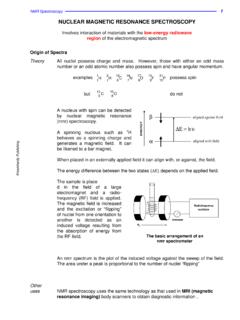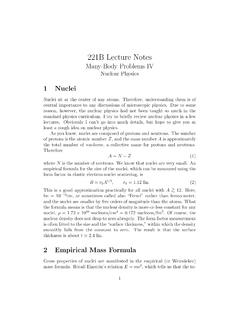Transcription of 3. Introductory Nuclear Physics – 1; The Liquid Drop Model
1 Each nucleus is a bound collection of N neutrons and Z protons. The mass number is A = N + Z, the atomic number is Z. and the nucleus is written with the elemental symbol 3. Introductory Nuclear for Z. Physics 1;. [ ]. A Z. The Liquid Drop Model 12. C, 13C, 14 C are isotopes of carbon all with Z = 6 and neutron numbers N = 6, 7, 8. The neutrons and protons are bound together by the residual strong or color force In fact, the neutron and proton are themselves collections of smaller fundamental quarks. 4He p In the standard Model . In addition there is Hadrons are collections of three quarks (baryons) or a a collection of bosons whose exchange quark plus an anti-quark (mesons).
2 This way they are able mediates the four to satisfy a condition of color neutrality. Since there are three fundamental forces. colors of quarks, the only way to have neutrality is to , W+-, Z0, 8 gluons, have one of each color, or one plus an antiparticle of the same graviton (anti-)color. Only quarks and gluons experience the color force and quarks are never found in isolation particle anti-particle Quarks are bound together by gluons - massless bosons with spin 1, like the photon, but unlike the The color force binds the quarks in the hadrons photon that has no charge, gluons carry color Each gluon is a linear combination (given by a Hermitian, trace-free, 3x3 matrix) of color-anticolor base states ( , SU(3)).
3 Red antired red antigreen red antiblue green antired green antigreen green antiblue blue antired blue antigreen blue antiblue A red quark emits a red-antigreen gluon which You might expect 9 combinations, but the trace free is absorbed by a green quark making it red. nature of the matrix means there are only 8. The This is going on all the time in the neutron combination red-antired+blue-antiblue+green-antigree n would allow interactions among hadrons that did not change color and are not observed The color force only affects quarks and gluons. The weak interaction allows heavier quarks and leptons to decay into lighter ones.
4 , All observable particles must be color neutral but n p + e + e udd uud gluons are not observable. They do not have to be d(Z = 1/ 3) u(Z = 2 / 3) + e + e color neutral (and aren t in the standard Model ) and if energy is provided p + e n + e For background on all this, read Mesons are quark-antiquark pairs and thus carry net spin of 0. or 1. They are Bosons while the baryons are Fermions. They There are two ways of thinking of the can thus serve as coupling particles. Since they are The rho meson with a strong force - as a residual color interaction made of quarks they experience both strong and weak mass of about 770 MeV.
5 Interactions. The lightest two mesons consist only of can be considered to be (like a van der Waal s force) or as the combinations of u, d, u, and d and are an excited state of the pi meson. It has the same exchange of mesons. Classically the latter quark content. was used. Name Made of Charge Mass*c 2 (sec). uu dd Exchange of (pseudo)scalar mesons like o 0 135 MeV (-17). 2 the meson give rise to an attractive force ud, du 1 (-8) Exchange of vector mesons like the and %. give rise to a repulsive force. At very short + 0 2 , occasionally e + + e- distances one has to consider the exclusion There are many more mesons.
6 Exchange of these lightest mesons give principle for the quarks rise to a force that is complicated, but attractive. But at a shorter range, many other mesons come into play, notably the rho meson (776 MeV), and the Nuclear force becomes repulsive. The Nuclear force is only felt among hadrons.! ! At typical nucleon separation ( fm) it is a ! very strong attractive force.! ! At much smaller separations between nucleons ! E t the force is very powerfully repulsive, which keeps ! Mc 2 / c the nucleons at a certain average separation.! ! Beyond about fm separation, the force ! The Nuclear force at large exponentially dies off to zero.
7 It is greater than the ! distances is not just small, Coulomb force until about fm! it is zero. ! The NN force is nearly independent of whether the ! Repulsive at short distances. nucleons are neutrons or protons. This property is ! called charge independence or isospin independence.! ! The NN force depends on whether the spins of the nucleons ! Nuclear density nearly are parallel or antiparallel.! constant. ! The NN force has a noncentral or tensor component. ! Since the nucleons are Fermions they obey FD. statistics 1/3. 3h 3 . p0 = n 8 . where n = fm 3 = 10 37 cm 3 is the density of n or p.
8 2. Here h = 10 27 erg s . This implies a speed for the nucleons p02. of about c / 4. and a peak Fermi energy, F = = 39 MeV. 2M. The average Fermi energy is 3/5 of this F = 23 MeV per nucleon As we shall see shortly, Coulomb energies are much smaller than this. To zeroth order the nucleus is a degenerate gas of nucleons confined by the (residual) strong force. Nuclear density is a constant. Deformation is an indication of Nuclear rotation Nuclear force is R A1/ 3 spin dependent The binding energy of a nucleus : - the energy available to hold nucleus together - For a bunch of well-separated nucleons: the binding energy is zero - Bring them together: strong force glues them together.
9 However, energy has to come from somewhere: binding energy must come from a reduction in Nuclear mass Formally, it is the difference between mass of component protons and neutrons and that of actual nucleus , related through E= mc2 : nb. BE(p) = 0. BE(A,Z) = Z mpc2 + N mnc2 M(A,Z) c2 BE(n) = 0. Binding energy is a positive quantity (even though the strong potential in which the nucleons sit is negative). Binding energy per nucleon ! the average energy state of nucleon is a sum of high energy surface nucleons with low energy bulk nucleons ! nucleus minimizes energy by minimizing surface area a sphere Semi-Empirical Mass Formulae Unless weak interactions are involved (to be A phenomenological understanding of Nuclear discussed later), the total energy released or binding energies as function of A, Z and N.
10 Absorbed in a given reaction Assumptions: Nuclear density is constant. Q = BE(species out) BE(species in). We can Model effect of short range attraction due to strong interaction by a Liquid drop Model . Coulomb corrections can be computed using electro This is measured in MeV where magnetism (even at these small scales). 1 MeV = x 10-6 erg. Nucleons are fermions at T=0 in separate wells (Fermi gas Model " asymmetry term). QM holds at these small scales " pairing term Nuclear force does not depend on isospin Liquid Drop Model Volume and Surface Term Phenomenological Model to understand binding energies.




